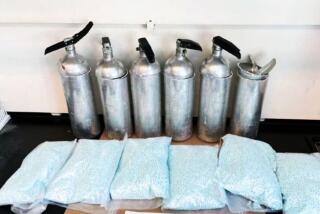Disarming Syria of chemical weapons highly complex, experts say
WASHINGTON — It may be possible for the United Nations to disarm Syria of its chemical weapons, but the complex operation probably would require years to complete and would be extraordinarily difficult while much of the country is consumed by civil war.
As the White House and its allies moved closer Tuesday to seeking U.N. support for a Russian proposal to collect and destroy Syrian President Bashar Assad’s vast arsenals of toxic weapons, veteran inspectors and other experts began to focus on the technical and logistic challenges such a plan would entail.
The biggest question is whether Syria would disclose its clandestine procurement systems, development and production infrastructure, chemical supplies, weapons stores, armed delivery systems, command-and-control networks and other details necessary to verify compliance.
“The Syrians would have to tell us basically everything, and they’d also have to confess to using chemical weapons, which they may be reluctant to do” because it could make commanders vulnerable to charges of war crimes, said Markus Binder, a chemical weapons expert at the University of Maryland.
Assad’s government also presumably would need to grant international weapons inspectors unfettered access to now-secret chemical weapons facilities and other sensitive systems controlled by the ruling elite.
Sen. Dianne Feinstein (D-Calif.), who chairs the Senate Intelligence Committee, said inspectors probably would seek to transfer weapons and materials from about 40 known facilities to a few neutral sites, either in Syria or a nearby country, so they could disable or destroy them.
“There would have to be consolidation of these sites,” she said.
The inspectors almost certainly would require armed security while Assad’s army grapples with a rebellion in much of the country. Some experts worry that extremist groups or other insurgents would target the inspection teams and try to seize or use the weapons.
“In Syria we have militants that may want to sabotage the whole thing,” said Raymond Zilinskas, a nonproliferation expert at the Monterey Institute of International Studies. “You would need security, and is that going to be an international force or will they depend on the Syrian army? There are all kinds of details that have to be worked out. I don’t think it’s going to happen very quickly.”
“There are two risks: the risk of the war coming to the weapons, in the form of getting caught in crossfire or attacked specifically, and the risk of the munitions themselves leaking,” said Tim Trevan, who worked with the U.N. teams that sought to disarm Iraq of chemical, biological and nuclear weapons after the 1991 Persian Gulf War.
Appearing before the House Armed Services Committee, Secretary of State John F. Kerry said Syria’s military had about 1,000 metric tons of chemical agents, including mustard gas, which causes horrific burns, and VX and sarin, which affect the nervous system.
Most of the sarin and VX are kept as precursor chemicals that may be mixed to form the deadly neurotoxin. Syria also possesses small rockets, artillery shells and other munitions pre-loaded with sarin.
The Obama administration says Assad’s forces fired dozens of small rockets loaded with sarin into rebel-held neighborhoods east of Damascus on Aug. 21, killing more than 1,400 people. Assad’s government has denied it.
Gen. Martin Dempsey, chairman of the Joint Chiefs of Staff, told the Senate committee that Syrian forces had moved their chemical weapons to bases under their control. That might make it easier to protect visiting U.N. inspectors, as well as ultimately to remove or destroy the munitions.
Lethal chemicals can be burned in special high-temperature incinerators, or combined with other compounds to render them inert. Doing either requires special handling and carries considerable risk of leakage or contamination. Some munitions may be so unstable that they are stored in airtight bunkers.
Inspectors might seek to fly some of the toxic materials and munitions out of Syria. In 2004, in a then-secret deal with Libyan ruler Moammar Kadafi, U.S. and British officials secretly dismantled Libya’s nascent nuclear weapons program and flew key components and supplies to the Oak Ridge National Laboratory in Tennessee.
Dismantling Libya’s stockpile of mustard gas, a blister agent made infamous in World War I, proved more difficult, however.
The 23 tons of toxic mustard was stored in 1-liter plastic jugs in padlocked warehouses. The containers were deemed too dangerous to move, said Donald Mahley, who oversaw the effort to dismantle Libya’s nuclear and chemical programs.
He said Libyan officials agreed to move the mustard to a military base that U.S. satellites could surveil, and plans were made to build a special incinerator nearby. The U.S. also destroyed the bombs built to deliver the mustard, Mahley said.
In May, the Organization for the Prohibition of Chemical Weapons, an international body based in The Hague that monitors compliance with the Chemical Weapons Convention, announced that Libya had destroyed 85% of its mustard, more than a decade after declaring it.
The inspection and verification process is far from foolproof. In Iraq, Saddam Hussein’s government offered a continually shifting list of weapons, facilities and personnel, leading to a complete breakdown of credibility with the outside world.
“In Iraq, they couldn’t explain to our satisfaction what had happened to several tons of material that their records say they had produced,” said Joseph Cirincione, president of the Ploughshares Fund, which works on nonproliferation issues. “They said it had been destroyed in the desert. We didn’t believe them. It turned out that it was true.”
The U.S. learned only after it invaded Iraq in 2003 to find and destroy Hussein’s weapons of mass destruction that they no longer existed.
More to Read
Sign up for Essential California
The most important California stories and recommendations in your inbox every morning.
You may occasionally receive promotional content from the Los Angeles Times.












